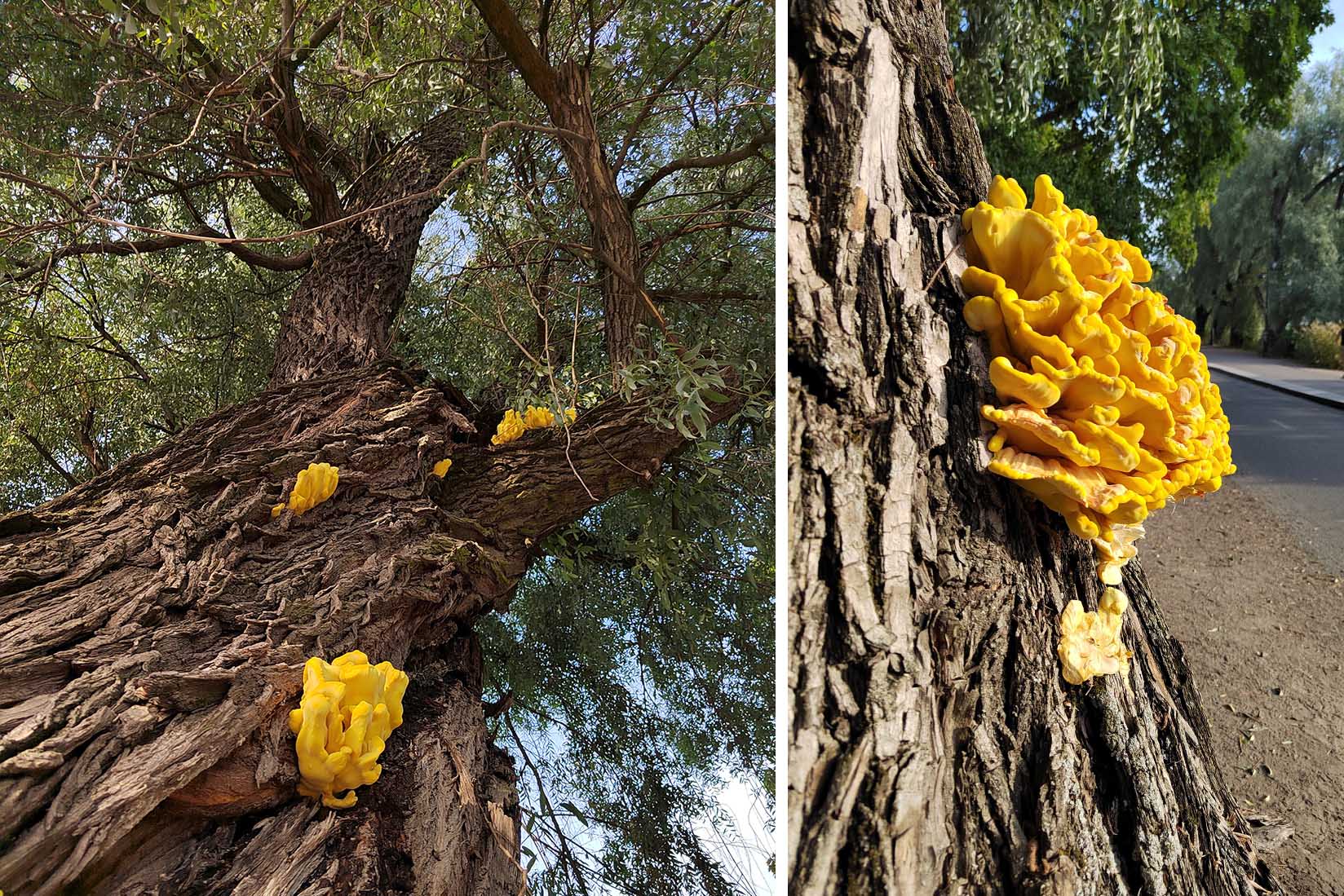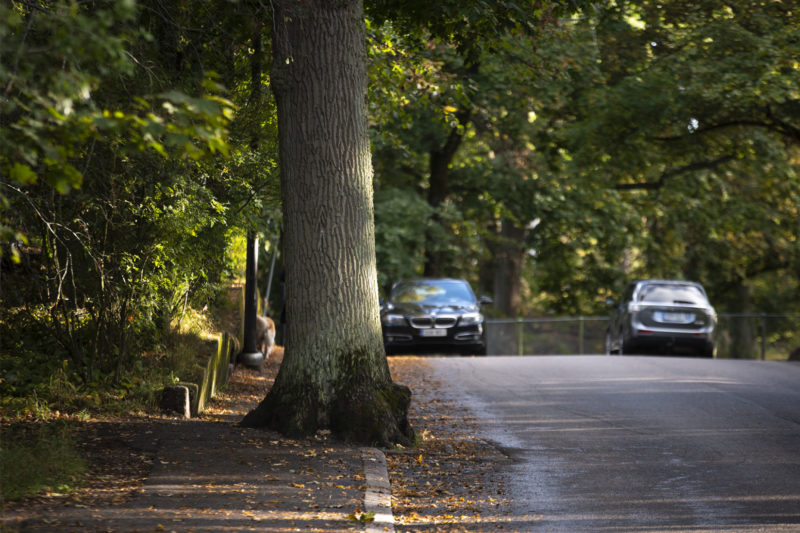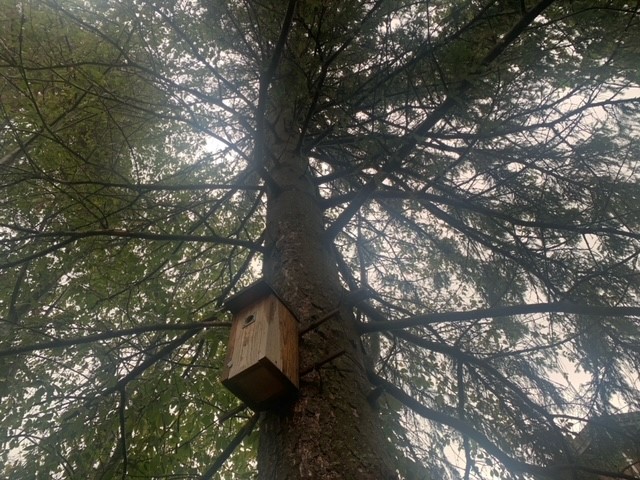
A tree in your garden looks like it might crash on your house in the next storm. Or, you can practically see the vitality of your forest plot seeping away. When should you be worried about the health of single trees or forest stands?
Experts talked to forest.fi about signs pointing to a need for extra measures because of the health of garden trees or forest plots. Arborist Teppo Suoranta listed eight signs of danger in garden trees, and Heikki Nuorteva, Senior Specialist at Natural Resources Institute Finland, listed seven signals of something being wrong in the forest.
1. Roots indicate history
Teppo Suoranta knows it is useful to be aware of the history of a tree in an urban environment.
’If, for example, there’s been an excavation near the tree, quite often no one has worried about its roots,’ Suoranta says.
People should start paying attention when they see an excavator near a tree. By the time you see a chain saw, it’ll already be too late.
The health of the root system has a direct effect on the whole tree.
’People should start paying attention when they see an excavator near a tree. By the time you see a chain saw, it’ll already be too late,’ Suoranta says.
2. The tree stands too deep
When Suoranta suspects a tree to be in poor health, he will examine it from the butt upwards. At ground level, the root flare at the tree base should be visible. According to Suoranta, the most common and most serious problem with trees anywhere in the world is that they have been planted too deep.
’It’s quite common that the tree stands too deep and the soil filling the hole is too compacted. You shouldn’t push the tree into the soil as you would a fence pole, because then the roots will not be able to breather properly. If it’s planted too deep, the tree will not thrive,’ Suoranta says.
3. Asphalting is a threat
Is there asphalting too close to the tree, so that access to water and oxygen becomes more difficult? Suoranta notes that being underground and out of sight, roots are often forgotten.
’”Roots are the forgotten victim languishing in their underground prison,” is how the former Helsinki City Gardener Pekka Jyränkö advised students of horticulture in 1977. Quite often, asphalting comes too close to the tree trunk and above its roots, which means that the tree will have much less access to oxygen,’ Suoranta explains.

The roots can be helped by aeration. This is done by blowing pressurized air into the soil, creating channels and holes.
’The channels should radiate outwards from the trunk. In this way, you can expose the roots and they get access to oxygen. You should then fill in the channels and holes with coarse stone chips or expanded clay, and that’ll be very helpful for the tree,’ Suoranta says.
4. External damage
At worst, injuries can completely finish off a tree. Typical sources of injuries for garden trees include string trimmers, snow ploughs and lawn mowers.
’Hundreds of thousands of trees have been killed by bringing the lawn mower too close to the trunk. The tree can be damaged so that its bark comes off. This sort of carelessness is all too common,’ Suoranta points out.

5. Decomposers and conks
Are there decomposers, bracket fungi, holes or cracks in the tree?
’How serious this is, must be assessed case by case. As a rule, you can always find some problem of this nature in a tree, but it’s their exact nature and severity that will determine whether you should attempt to save the tree,’ Suoranta explains.
Suoranta advises that you should contact a professional if you feel uncertain and cannot identify the different decomposer fungi, for example, all of which attack the tree in their own way.
’They’re enormously variable as to how aggressive they are. The Inonotus ulmicola can bring an elm under risk in a couple of years, while the Oxyporus populinus can take 20–30 years to achieve the same in a maple. This latter polypore is not aggressive.’
6. Exceptional features in tree structure
Suoranta says that the structure of a tree can affect its health and is also important for safety.
’Are the branches securely connected to the trunk and do they have a collar?’ Suoranta asks.
A distressing problem is ingrown bark.
’If a branch is not properly attached to the trunk and as it gains weight over time, it may split off in a storm or under a heavy load of snow. This can actually be dangerous to people,’ Suoranta warns.
Suoranta mentions that using binoculars allows you a better view of possible problem spots.
7. External appearance and foliage
For Suoranta, a tree’s appearance can give a lot of clues about its vitality.
’If the leaves are small and sparse and have a bluish tinge, quite commonly this is because of problems with the roots,’ Suoranta says.

Suoranta explains the ’division of labour’ in a tree:
’The roots on the south side look after the canopy on that side, but not on the north side. If there are dead branches on just one side of a tree, it’s possible that the roots suffer from the girdling roots syndrome, which suffocates the affected side of the tree. To identify this, you need experience,’ Suoranta says.
8. Risk-prone species
’Tree species are different in terms of how well they can manage with the stresses of built environment,’ Suoranta says.
Common oak, for example, manages well because of being extremely hard. Suoranta considers European lime to be the species best suited to urban environments.
European lime is very widely used. It manages wonderfully in urban environments. Landscape planners must be extremely well aware of the characteristics of each species, to be able to select the best species for each spot.
’European lime is very widely used. It manages wonderfully in urban environments. Landscape planners must be extremely well aware of the characteristics of each species, to be able to select the best species for each spot,’ Suoranta says.
Still, any species can experience problems, and different diseases have a different impact on each species.
’Ash is plagued by the fungus causing ash dieback, especially in the Åland islands. Elm is attacked by the very aggressive Inonotus ulmicola, more severely than we first thought,’ Suoranta says.
A species with soft wood is normally less sturdy than those with hard wood. Species with soft wood include such trees as willows and poplars, which can, on a good site, grow into real giants. Of domestic broadleaves, Suoranta favours the birch.
’Birches are useful trees. Their seedlings are not expensive, and they’re easy to maintain as they don’t need as much pruning as European limes,’ Suoranta explains.

’Scots pine is reliable and sturdy, but Norway spruce, with its shallow roots, is not at all suitable anywhere with a lot of traffic,’ Suoranta warns.
’Black alder has recently gained in popularity, but it has the drawback of having a fairly fragile wood.’
’You should try and find a spot that is as similar as possible to its natural habitats.’
In Suoranta’s opinion, arborists should always base their conclusions on careful investigation.
’That includes recommendations on how to care for the tree and how to schedule any operations. Or maybe all you can do is recommend felling the tree, which unfortunately is often the case. When you investigate a tree, you must assume responsibility for the outcome. If you don’t, you work completely against all professional ethics,’ Suoranta says.
Evaluation of forest farms is often affected by owner’s goals
According to Heikki Nuorteva, Senior Specialist at Natural Resources Institute Finland and Doctor of Agriculture and Forestry, there is no unambiguous definition of when a forest plot is in bad shape.
How the condition of a forest is interpreted depends partly on the beholder as well as on the owner, always bearing in mind the dictates of the revised forest legislation.
’A great deal depends on the goals that the owner has regarding the plot,’ Nuorteva points out.
The definitions of the condition and quality of a forest vary depending on whether the owner focuses on financial revenue, conservation, biodiversity, multiple use, landscape values or, in some cases, leaving everything to Mother Nature.
As regards factors that cause damage, it is important for owners to know the Forest Act and the Forest Damage Prevention Act, as they provide indications on how to prevent the tree stock from perhaps deteriorating in a way that the owner doesn’t wish.
’As regards factors that cause damage, it is important for owners to know the Forest Act and the Forest Damage Prevention Act, as they provide indications on how to prevent the tree stock from perhaps deteriorating in a way that the owner doesn’t wish,’ Nuorteva says.
Nuorteva lists seven things that you should pay attention to, if you want to protect your forest from the most common causes of damage, in order to achieve a forest with as much vitality and diversity as possible. At the same time, the forest will then provide a reasonable financial income.
1. Wrong species on the wrong site
Heikki Nuorteva stresses that there should be a good match between species and growing site.
’The traditional rule of thumb is to grow spruce and birch on richer soils and pine on poorer ones. In areas with plenty of elk and deer, it is true that in recent years regeneration has tended to favour spruce, to prevent damage to young stands,’ Nuorteva says.

2. Environmental factors cause stress on trees
Growing spruce on soils that are too poor or dry will later expose the trees to drought and insect damage in particular, even when damage by elk is more or less successfully avoided in young stands.
Still, the matter is not quite clear-cut. Damage by voles and the large pine weevil and suffocation by grasses can threaten all species at the early seedling stage.
’Removing grasses around small seedlings helps them survive. Depending on the owner’s goals, the situation may be improved by removing trees of technically poorer quality, such as trees whose trunk or canopy has been damaged, and any that have exceptionally strong branches and broad canopy, Nuorteva advises.
3. Visible signs of pests
If bark in young stands has been gnawed at, Nuorteva says this may point to damage by snout beetles and voles. If the number of perished young trees is high, it may also be due to suffocation by grasses or insect or fungal damage.
Stunted growth may be due to an excessively poor growing site, especially with spruce. Damage to branches and tops may be caused by cervines. The sudden browning and dying of pines and junipers may be due to root rot.
4. Over-density of stands
In excessively dense stands, trees may deteriorate and die. Consequences of over-density listed by Nuorteva include, among others, premature death, slowing down of growth, deterioration of living canopy and snow damage.
The ratio of living canopy to tree height may decrease to a point where the tree no longer survives in the mutual competition, they become dilapidated or die prematurely and suffer from snow damage, among other things.
’The ratio of living canopy to tree height may decrease to a point where the tree no longer survives in the mutual competition, they become dilapidated or die prematurely and suffer from snow damage, among other things,’ Nuorteva says.
He continues that many diseases caused by fungi, such as Melampsora pinitorqua and species of Lophodermium in pines are more likely in very shady stands with a humid microclimate.
’Timely thinning gives more light and more space for the roots, and will improve the growth potential of the best specimens. Less density will also improve the ”air conditioning” and thus reduce the possibility of airborne fungal infestation,’ Nuorteva says.
5. Over-aged stock
According to Nuorteva, in more mature stands it is particularly the presence of over-aged trees that increases many kinds of insect and fungal damage.
’This is particularly true for logwood-dominated spruce stands in southern Finland, which are increasingly under attack from the European spruce bark beetle, as well as the Pityogenes chalcographus, Polygraphus species and species of longhorn beetles,’ Nuorteva says.
The damage may be manifested in many ways, such as the marks left by feeding insects: holes, exuded resin, presence of powdered wood on the trunk, loosening of bark, dying branches or canopies, damage to trunks and decay.

’Root rot and the Armillaria borealis mushroom easily cause decay, particularly to spruce and pine. Birch has special pests of its own. In mature forests, death or a significant deterioration of the value of logwood may come as a surprise, even within a single season,’ Nuorteva says.
Drought can often make trees vulnerable to insect damage. If a spruce top suddenly dries, maybe for several metres, a possible culprit may be any of the following beetles: the Pityogenes chalcographuses, a Polygraphus species or the Pissodes pinifilus.
In mature forests, death or a significant deterioration of the value of logwood may come as a surprise, even within a single season.
The death of stout spruces may be due to such beetles as the European spruce bark beetle, species of Tetropium or Polygraphus, the Pityogenes chalcographuses or root rot, especially during hot and dry periods. The tree may also suffer from trunk rot.
Nuorteva explains that infestation by the rust fungus Cronartium in pine is visible as longitudinal scoring of the trunk and dying branches and canopy.
Another pest is the pine engraver Ips acuminatus, which causes the canopy to turn brown and quickly die. At the same time, the wood in the branches may gain a strong blue tinge.
The appearance of the common pine shoot beetle will often be the final stage in the death of a tree.
The Heterobasidion fungus causes butt rot in Scots pine. The affected tree may also rapidly turn brown and die, or will more easily be felled by storms.

Hot and dry periods expose pines to several pests attacking their needles, especially the red pine sawfly, the common pine sawfly and the bordered white (pine looper) moth.
’Pests weaken the trees and expose them to many other pests, as well as slowing down their growth. The most recent arrival in Finland is the Sphaeropsis sapinea fungus that causes tip blight. It was only last autumn that it was identified as the cause of pine death here,’ Nuorteva says.
’In the present climate the Black arches (nun moth) may become a cause of severe damage, though so far, it has caused only limited problems,’ Nuorteva judges.
Tip blight is a problem during cold, rainy summers, especially for the lower branches of trees, seedlings and even whole trees. Needle loss is also caused by needle-attacking fungi in many areas.
The birch pests listed by Nuorteva include the Scolytus ratzeburgi and the Trypodendron signatum beetles, Weakened trees can then be infested by many species of geometer moths and decomposer fungi.
6. Damage adjacent to felling sites
Trees felled by storms may occur adjacent to felling sites. Nuorteva says that trees turning brown, dying or growing more slowly in these areas may be due to insect damage or aridity.
Storm damage and wind-felled trees expose healthy trees to many kinds of consequential damage, if windfalls are plentiful and they have not been removed rapidly enough.
’Storm damage and wind-felled trees expose healthy trees to many kinds of consequential damage, if windfalls are plentiful and they have not been removed rapidly enough,’ Nuorteva says.
The Forest Damage Prevention Act contains provisions on the harvesting and storaging of trees, with a view to avoiding fungal and insect damage.
7. Aridity and other plights
According to Nuorteva, dry and hot periods in themselves can be enough for trees to die.
’Often, significant shortages of nutrients are visible as stunted growth, which may also be caused by the Aradus cinnamomeus bug in young pine stands on dry heaths,’ Nuorteva says.

The common pine shoot beetle slows down the growth of pines and damages the top. In late summer, spruce may be troubled by the Chrysomuxa ledi fungus, though it has little impact on growth. The fungus is not deadly, but will damage and kill the youngest needles.
The Melampsoridium betulinum fungus attacks birches in late summer, turning their leaves prematurely brown or yellow. It is not deadly, though Nuorteva says it may stunt growth.
English translation: Heli Mäntyranta
Professional equipment for investigating damaged trees
- A micro drill that leaves a scarcely visible mark in the tree. A good drill costs EUR 9,000.
- A Picus Sonic Tomograph, which emits sound waves received by steel spikes shot in advance into the tree trunk at a uniform height. The time taken by the sound to reach each spike is shown by the device. The lower the speed, the more decay there is in the tree, because sound waves will circumvent decayed parts. In healthy wood, sound waves will travel without hindrance and thus faster.
- The sound waves create an image of the health of the wood on the laptop screen. The screen will show the share of healthy wood and the degrees of decay. The device costs EUR 25,000, and using it requires a great deal of practice.
- The results obtained with the micro drill and the tomograph should be convergent.
- A Calliper device measures the size and shape of the tree trunk, which is an important starting point for all measurements. The sound wave investigation will not be successful if the shape and size of the location to be measured is not appropriate.
Source: Teppo Suoranta
